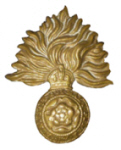



No.GS/29054, Private, William George WELLS
Aged 41

|
William Wells was born in Wickhambrook,(Risbridge Q3-1876 4A:479), son of Eliza WELLS.
1881 census...Aged 5 he was at Crow Cross Green, Wickhambrook where his unmarried mother [39] was housekeeper to widower William Martin [50] farm labourer and his two sons Harry [17] a farm labourer, and Frederick [7]. William's brother Charles [9 months] was also there. All were born in Wickhambrook. 1891 census...Aged 15, a farm labourer, he was at The Duddery, Wickhambrook with his mother ( a tailoress) and brother Charles. 1901 census...Aged 25, a farm labourer, he was at Withams, Wickhambrook with his mother. 1911 census...Aged 34, a farm labourer, he was at the Cottages, near Withams, Wickhambrook with his mother and brother Charles (farm labourer). |

|
He enlisted in Newmarket. The 1st Battle of the Somme was from July 1st to November 18th 1916, as part of that battle the 7th Battalion, Royal Fusiliers were engaged in Battle of the Ancre on November 13th. From the book "The Royal Fusiliers in the Great War" by H. C. O'NEILL, O.B.E. comes the following detail of the 13th November 1916:- This unit formed part of the 190th Brigade of the 63rd (Naval) Division, which was engaged immediately north of the river. At 5.45 a.m. C and D Companies advanced with the H.A.C. on their right. On their left was the redoubt which, for the whole of the day, made a deep salient in the British position. Both of the leading companies met with heavy rifle and machine gun fire. The first two waves of C were held up by the remains of the German wire, and after losing heavily returned to the starting point. There, in our front line, were the second two waves and about 60 men from other battalions. It was so foggy that no one could see what was actually happening, and Captains Foster and Clarke decided to make another advance with all the men in the trench. The men came again under heavy fire, and all the platoon commanders - 2nd Lt W. Ford, 2nd Lt. St. Aubyn, 2nd Lt Bouchier and Sgt Cookson - became casualties. Nevertheless, the German front line was rushed in five minutes. In it were found 20 German dead, and one officer and 50 men surrendered. A machine gun was also captured. The trench line was consolidated and blocked against the German strong point, and the company remained there until ordered to proceed to the Green line. Sergeant Bright with three Lewis guns and 13 men was left to hold up the German strong point. The Green line was reached with little loss except from snipers and was held till about 9 p.m., when, on relief by the H.A.C., they went back to the German front line. D Company, in the meantime, had made three attempts to advance, the last with the elements of several other battalions, and had failed to make headway against the German rifle and machine gun fire. At the end of the third attack the company was reduced to 50, and Captain Rattigan decided to hold on where he was in front of the German wire. They remained in this position for four and a half hours- During this time Captain Rattigan was killed, and 2nd Lt Downing, finding a mine shaft leading back, went down it, reported to battalion headquarters and was ordered to bring the remains of the company back to the British front line. Sergeant Bright held up the German strong point all day. He was not a little assisted by the supply of German bombs found in the trench, and by Private Hawkesley, who daringly lay out along the parapet with a Lewis gun. Captain Goddard, of B Company, took over this post at 3 p.m., and the captured trench was organised. The battalion was reorganised about 2 a.m. on November 14th. The losses to the Battalion were 117 killed, of which 28 are named on the Thiepval Memorial to the Missing of the Somme at Thiepval
click here to go to the Commonwealth War Graves Commission website for full cemetery/memorial details |